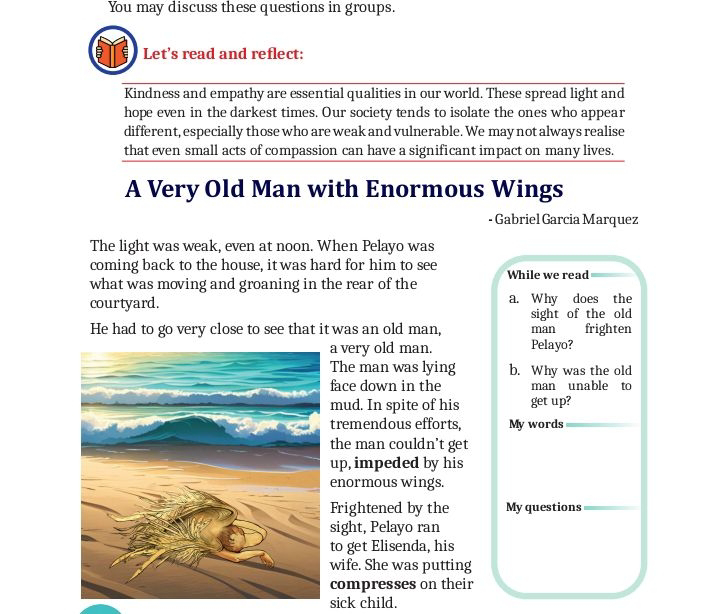His First Flight Activity
HIS FIRST FLIGHT
Liam O' Flaherty
Review:
Liam O’ Flaherty pictures the Irish Sea coast, and bird life through his
inspirational story of a seagull in “His First Flight”. Bird life and habits are revealed clearly through the story. A bird attains independence only when it succeeds in flying. Flying encourages a bird to cover the land and the seas through air. One such young seagull and his first flight overcoming fear is the central character and theme of the story.
The young seagull is alone on the ledge, his usual place of rest. His head is
down, he is depressed. The reason is that his brothers and sister (siblings) have learnt to fly, but he hasn’t .His attempts have not become successful. Somehow the fear of failure and the lack of confidence has pulled him down. He has formed a judgment in his mind that his wings will never support him even though his wings are larger and stronger than the others. He cannot muster up (gather) courage to take, that plunge or leap which will inspire flying .His parents scolded him, and threatened him to starve on the ledge, if he did not fly. But all this was nothing. He was scared to death.
Now 24 hours of tension has passed. His parents have tried their best to encourage him, to make him fly, but they failed. Moreover he had seen his parents perfecting his siblings in the art of flying, teaching them to skim the waves and dive for fish. The young seagull felt jealous seeing his older brother catch a herring and eat.
The parents wanted him to feel jealous, they wanted to show him their
anger in his refusal to fly. He must not be a coward, a fool. Birds are born to fly, and if this seagull did not have the courage to do he would be a failure. Other birds would make fun of him. He would die of starvation.
Now it was evening, he was hungry. Not a single bit of food on the ledge. His
stomach hurt from starving. But still he was not ready to try and fly. But moreover the funny fact was that he was burning his head, thinking of a method to reach his parents without flying. Between him and his parents there was a deep crack.
He tried to make his parents notice his presence. He stood on one leg, with
the other leg hidden under his wing, closing his eyes and pretending to fall
asleep. But no one saw him. Again he secretly viewed his brothers and sisters lying and dozing after their first day of flying. His father was preening his feathers. But his mother, she was the only one who was still worried. She was looking at her young one. She wanted to give him some more inspiration, so she started pecking at a piece of fish .When she rubbed her beak on the rock, the young seagull grew mad. “Food….oh God its so long since I’ve had some food. His mother understood his needs. She cackled ga,ga,ga…. He too cried out loud. To his surprise, he saw his mother pick up
a piece of fish and fly towards him. As he came nearer and nearer, his heart
jumped with excitement. The thought of food bought water in to his mouth.
But as she came nearer the rock, she halted. He unknowingly dived at the
food, and he fell into open space. And he felt frightened. But the fear lasted
only for a moment. He spread his wings outward and started to fly. He was soaring. He was so happy. He howled with joy. His family too came to accompany his joy. The whole family soared and dived through the air. He forgot his fear. Next he came on to the sea. His feet fell into water. He thought he would fall, but his belly touched the water .He felt balanced. He
could fly and float too. Thus he made his first flight.
Activity - I
1. What is the theme of the story?
“Making a leap to fly high in the skies, overcoming fear and weakness is the
theme of this story. To fly is the life purpose of a bird .Only by flying can it survive to get its food. It has to be independent because parents cannot provide food always. We too must learn life from the young seagull. We must overcome fear, shyness, nervousness and all unnecessary thinking and strive hard to reach out goal. The importance of ‘family’ as a source of inspiration and motivation is also the central idea conveyed through the story of the seagull .The mother of
the young one is the real motivator who is responsible for the “First Successful Flight”.
2. What do you think is the real crisis faced by the young bird?
‘FEAR’ is the real crisis.
‘Fear’ in many forms.
Firstly he has no self confidence. He highlights his negatives and disabilities
more than his qualities and abilities .He also compare himself with his siblings.
Secondly, he fears that he will fail.”FAILURE” is impossible to him. His ego doesn’t allow it. So he cannot make the big leap which will enable him to fly.
He still looks down. His head must look up.
Thirdly, he is judgmental. He has formed a vision that his wings will not
support him to fly. He is not willing to try and do so.
So we can infer that his crisis is actually a mental crisis.
3. What is your impression of the reaction of the parents in the story?
Parents are the reason why children grow up safely in this world. They protect, nurture and build up children to make them USEFUL citizens. It is the motivation and inspiration they give to children which make them rise up the ladder of education and social status and financial security.
To a bird, whose life purpose is to fly high and find food for survival a parent
must make sure that the young bird must learn the art of flying at the earliest .The family in this story is the perfect example of the characteristics mentioned above.
They inspire, motivate and promote him. They give the first ‘push’. They
love the young seagull, and when he backs out they show him anger. The mother is wonderful , she doesn’t give up until her son makes his first flight. The father and siblings too take part in every need of his .The family enjoys together when he flies and catches food.



Comments
Post a Comment
Please share your feedback and questions